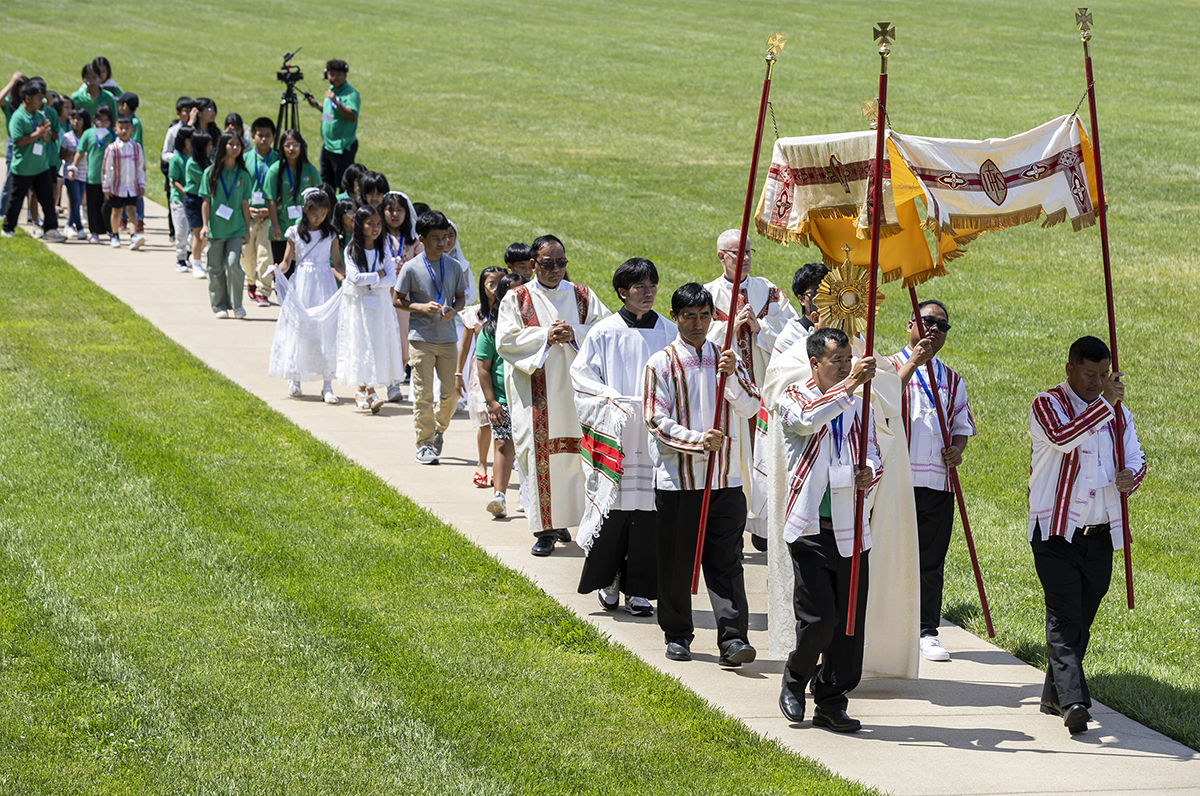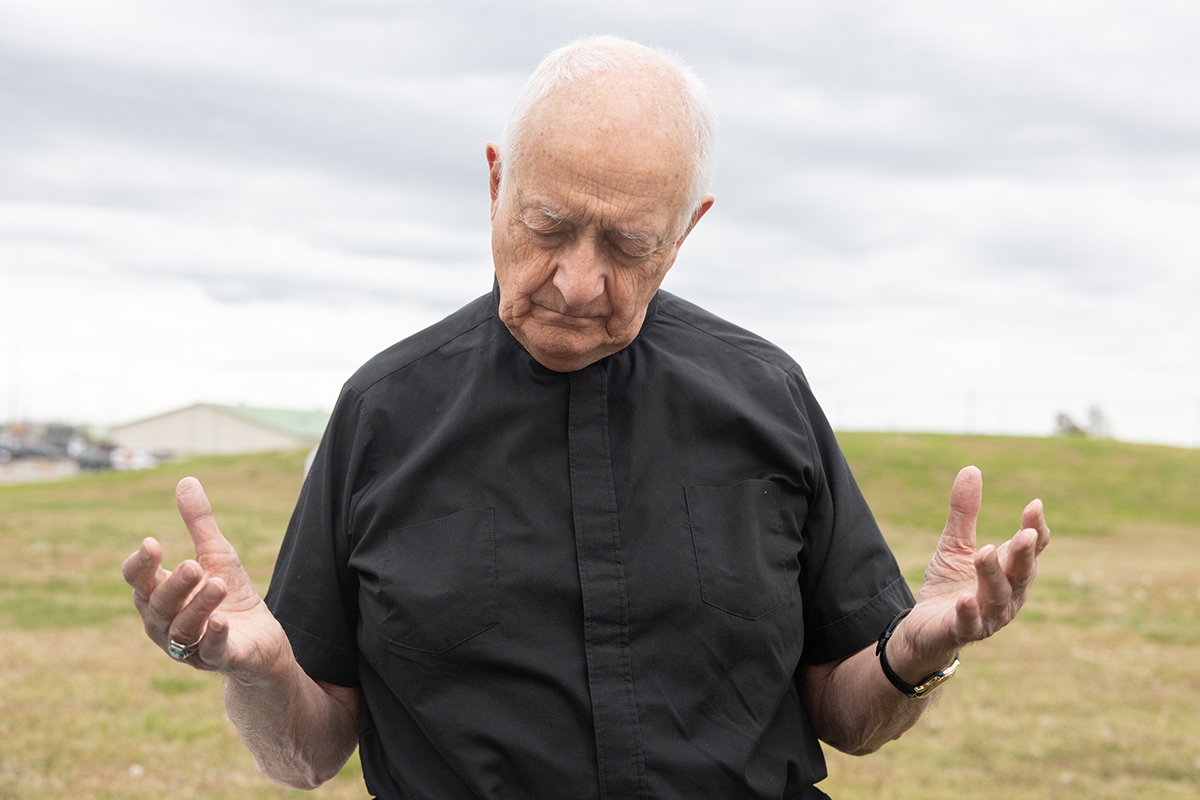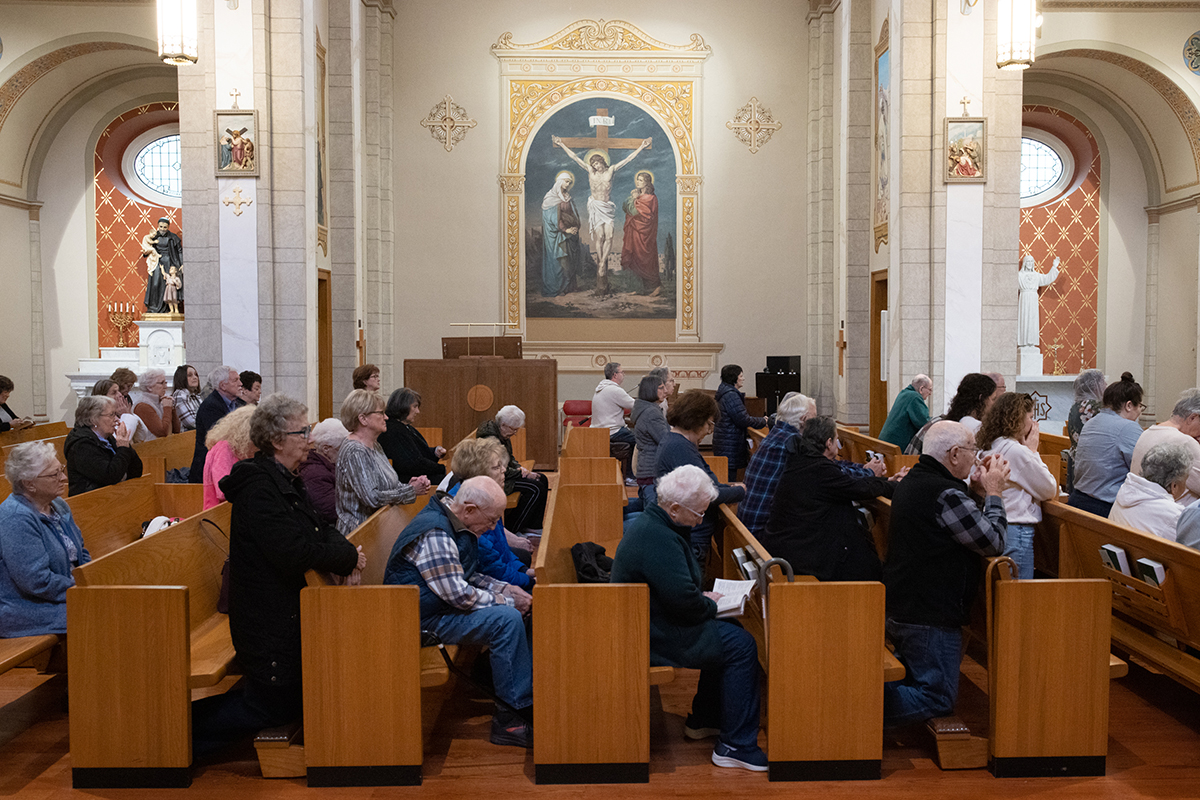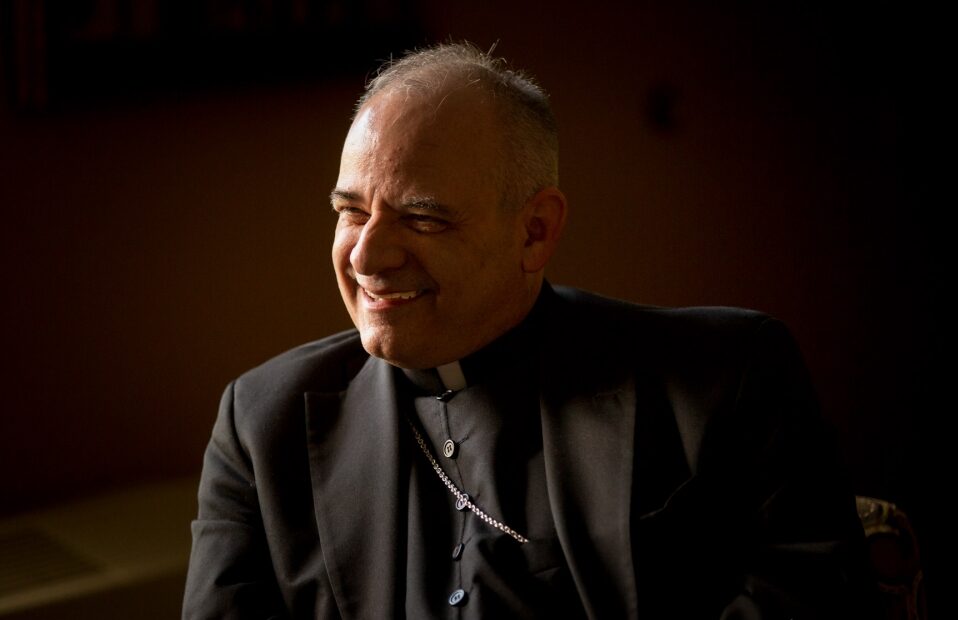A look at the prelates of the Archdiocese of St. Louis

Bishop Louis V. DuBourg
The first bishop to use St. Louis as his see city was Bishop DuBourg, a native of the French island of Santo Domingo (now Haiti) who had moved to France at age 2. As Bishop of Louisiana and the Floridas, he made St. Louis his episcopal headquarters from 1817 to 1820. On New Year’s Day 1818, he offered the first pontifical Mass in the vast area of Ste. Genevieve on his way upriver to St. Louis. Bishop DuBourg brought the Vincentians, the Jesuits and the Religious of the Sacred Heart to St. Louis. When the Louisiana Territory was split into two dioceses in 1826 — St. Louis and New Orleans — Bishop DuBourg resigned and returned to France. He died in 1833.

Bishop Joseph Rosati, CM
Bishop Rosati, founder of St. Mary’s College and seminary in Perryville and superior of the Congregation of the Mission (Vincentians) in the New World, became the first bishop of the Diocese of St. Louis in 1827 after having served as the first administrator of both the St. Louis and New Orleans dioceses. The St. Louis Diocese then covered an area nearly that of continental Europe. Bishop Rosati remained the administrator of New Orleans until June 1830 while leading the Diocese of St. Louis. The Cathedral of St. Louis, now called the Basilica of St. Louis, King of France (Old Cathedral), was built in 1831, during Bishop Rosati’s tenure. A native of the province of Lazio, Italy, Bishop Rosati died in Rome in 1843.

Archbishop Peter R. Kenrick
Archbishop Kenrick, originally of Dublin, Ireland, became the Archbishop of St. Louis in 1843, shortly after the death of Bishop Rosati. In 1847, Bishop Kenrick became the first archbishop of St. Louis when the diocese became the third metropolitan see in the country. Three years later, the extent of his jurisdiction was contracted to the state of Missouri. The original St. Louis Diocese was broken up to make — besides St. Louis — the Dioceses of Dubuque, Nashville, Chicago, Milwaukee and St. Paul. Archbishop Kenrick was the metropolitan archbishop of these sees. He took an active part in the Vatican Council, 1869-70. In 1891, the “Lion of St. Louis” celebrated his 50th anniversary as a bishop, the first such occasion in the history of the Catholic Church in America. Archbishop Kenrick was known for his positive treatment of immigrants, keen administrative abilities, his building up of the diocese and his qualities as a scholar. He resigned as Archbishop of St. Louis in 1895 and died in St. Louis the following year. By his death, some 18 new sees had been erected out of the original Diocese of St. Louis.

Archbishop John J. Kain
Archbishop Kain was decreed by Rome as coadjutor (successor) of the Diocese of St. Louis in 1893 and installed as archbishop in 1895. Born in Virginia, he was the first native-born American to become Archbishop of St. Louis. Archbishop Kain served eight years. He was considered zealous, capable and well-meaning, with a strong theological background and acumen. During his tenure, he gave full support to the parochial school system and chose the future site of the Cathedral Basilica of Saint Louis. He died in Baltimore in 1903.

Cardinal John J. Glennon
Cardinal Glennon was named in 1903 at age 40 as coadjutor of St. Louis with the right of succession. Cardinal Glennon was recognized as a great orator and was known as the Cathedral Builder because of his work in the erection of the New Cathedral, now the Cathedral Basilica of Saint Louis. During his term, several charitable institutions were started. While he was archbishop, the Church prospered, with many vocations and religious institutes flourishing, and the Archdiocese of St. Louis grew significantly in the number of parishes and parochial schools, expanding well beyond the City of St. Louis to the suburbs. Major and minor seminaries, new hospitals and diocesan high schools also were erected. He inaugurated a program, known as the Colonization Movement, where he invited colonists to come from Italy, Austria, Russia, Poland and Germany to his diocese. He helped by building up rural communities and giving aid in the form of parishes and priests to staff the churches. In Dunklin County, for example, he purchased 12,000 acres of land in 1905 and gave it to homesteading Catholic families. Two other communities in rural Missouri — Knoxville in Phelps County and Wilhelmina in Dunklin — were set up through Cardinal Glennon and his Colonization Realty Co. He died in his native Ireland on the way home from Rome after being made a cardinal at the age of 83 in 1946.

Cardinal Joseph E. Ritter
Born in New Albany, Ind., Cardinal Ritter was appointed archbishop of the St. Louis Archdiocese in 1946. He was proclaimed a cardinal in 1961. Cardinal Ritter was recognized as an administrator, leader in integration, ecumenist and man of deep personal piety. Within a year of his arrival, Archbishop Ritter desegregated the archdiocesan schools. He was instrumental in beginning the work of revitalizing the inner city, including a renewal of the archdiocese’s institutions, inauguration of the Human Rights Commission, development of an inner-city apostolate and other actions aimed at achieving integration and a better life for the city’s poor. He had a children’s hospital built as a memorial to his predecessor, created an archdiocesan Commission on Ecumenism, launched the St. Louis Review and began a radio and television apostolate, inaugurated an annual capital funds drive to meet building needs, continued the mosaic work in the Cathedral Basilica of Saint Louis and continued the archdiocese’s parochial and high school expansion efforts. During his reign, the archdiocesan boundaries again were adjusted and realigned, leaving 10 counties surrounding the City of St. Louis within the archdiocese’s territory. Cardinal Ritter was viewed as open to new ideas and seen as a progressive leader of Vatican Council II, 1962-65, at which he attended all sessions. It also was during his reign that the St. Louis Archdiocese in 1956 founded a mission in Bolivia — the first established by a U.S. diocese. He also was a strong supporter of the Society for the Propagation of the Faith. He died in St. Louis in 1967, a little over a month before his 75th birthday.

Cardinal John J. Carberry
Cardinal Carberry, a Brooklyn native, was named by Pope Paul VI as fifth Archbishop of St. Louis in 1968. He was made cardinal in 1969. He emphasized allegiance to the papacy and a strong Marian devotion During his tenure, he established new county parishes and St. Patrick Parish Downtown, instituted the archdiocese’s diaconate program, completed the high school and parish expansion programs that had been underway and continued the effort to guide the inner city toward restoration. Cardinal Carberry also was chosen by his fellow bishops for several leadership roles, including vice president of the National Conference of Catholic Bishops and as a delegate to three world Synods of Bishops. He made the archdiocese a national leader in the pro-life movement immediately following the U.S. Supreme Court’s pro-abortion rulings in 1973. He retired at age 75 in 1979 and was appointed apostolic administrator until the installation of a new archbishop in May 1980. He died in 1998 in St. Louis.

Archbishop John L. May
Archbishop May, born in Evanston, Ill., was appointed Archbishop of St. Louis in 1980. Like his predecessor, Archbishop May was known as a national leader, serving terms as vice president and then president of the National Conference of Catholic Bishops. He was recognized for having strengthened ties between the Vatican and the Church in the United States. During his episcopacy, he was an accessible pastor. He supported the revival of the Archdiocesan Pastoral Council and the formation of deanery and parish councils. Archbishop May advocated ecumenical dialogue, desegregation of public schools and improved race relations. During his tenure, he completed the mosaic work in the Cathedral Basilica of Saint Louis and consolidated the seminary system. He named the first chief financial officer, a layperson, and the first woman superintendent of schools. He often led calls for more aid for the poor and oversaw and expansion of Catholic Charities’ programs for the needy and pro-life assistance for women with crisis pregnancies. He retired in 1992 and died in St. Louis in 1994.

Cardinal Justin Rigali
A native of Los Angeles, Cardinal Rigali was installed as the eighth bishop/seventh archbishop of the Archdiocese of St. Louis in 1994. During his episcopacy, he stabilized the archdiocesan finances and oversaw a successful $55 million capital campaign that established endowments to help support future needs in the archdiocese. He established the first strategic pastoral plan for the archdiocese and had the archdiocese take over the direction of Kenrick-Glennon Seminary from the Vincentian Fathers. Then-archbishop Rigali continued the strong pro-life efforts of his predecessors and promoted sound values in the areas of morality, education and family life. He strongly emphasized the promotion of eucharistic adoration throughout the archdiocese. He actively promoted vocations, evangelization efforts and ministry to young people. Those efforts were strengthened by St. John Paul II’s pastoral visit to the archdiocese on Jan. 26-27, 1999. Cardinal Rigali was appointed in 2003 by St. John Paul II to be the Metropolitan Archbishop of Philadelphia, and was installed in October of that year. In September 2003, he was named a cardinal by Pope John Paul II. He lives in retirement in Knoxville, Tenn.

Cardinal Raymond L. Burke
Cardinal Burke, born in Richland Center, Wis., was appointed the ninth bishop/eighth archbishop of the Archdiocese of St. Louis in December 2003 and installed in January 2004. He was recognized as a standard-bearer for the Church’s pro-life stance; a strong promoter of the New Evangelization efforts; an advocate for vocations, particularly the priesthood; and a devotee and promoter of the Sacred Heart and Our Lady of Guadalupe. He played an instrumental role in the campaign against a statewide initiative to constitutionally protect embryonic stem-cell research and human cloning. Declaring Kenrick-Glennon Seminary as the heart of the archdiocese, he began an effort to enhance its programs, infrastructure and facilities. During his tenure, he served as a member of the College of Judges of the Supreme Tribunal of the Apostolate Signatura, the Church’s highest court. He was appointed prefect of the Supreme Tribunal of the Apostolic Signatura in June of 2008. He was named a cardinal in 2010 by Pope Benedict XVI.

Archbishop Robert J. Carlson
Archbishop Carlson, a native of Minneapolis, was appointed the 10th bishop/ninth archbishop of St. Louis in April 2009 and installed in June 2009. He was known as approachable, pastoral, humble and, with a genuine love for people, always mixed in a sense of humor. Each year he hosted a pastoral assembly as a forum of communication for leaders in parishes, and he established the Lay Formation Program. He appointed the first woman chancellor, inaugurated the Legatus pro-life prayer breakfast and declared Catholic education his first priority. His Mission Advancement Initiative and Alive in Christ effort focused on strengthening Catholic schools. He established the Roman Catholic Foundation of Eastern Missouri, which conducted the most successful capital campaign in the history of the archdiocese, raising more than $110 million for grants, scholarships and other needs. He brought in the Catholics Come Home program to welcome back Catholics who left the Church. He spoke out on abortion, religious liberty, immigration and the racial divide in St. Louis. Under his leadership, enrollment increased steadily at Kenrick-Glennon Seminary. Archbishop Carlson established the Rural Parish Clinic to provide health care and led the formation of the St. Joseph Housing Initiative. For more about Archbishop Carlson’s time in St. Louis, see www.archstl.org/st-louis-review/2020-08-10
Bishop Louis V. DuBourg The first bishop to use St. Louis as his see city was Bishop DuBourg, a native of the French island of Santo Domingo (now Haiti) who … A look at the prelates of the Archdiocese of St. Louis
Subscribe to Read All St. Louis Review Stories
All readers receive 5 stories to read free per month. After that, readers will need to be logged in.
If you are currently receive the St. Louis Review at your home or office, please send your name and address (and subscriber id if you know it) to subscriptions@stlouisreview.com to get your login information.
If you are not currently a subscriber to the St. Louis Review, please contact subscriptions@stlouisreview.com for information on how to subscribe.






